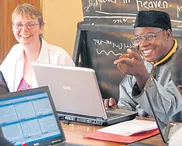Camilla Lloyd reflects on getting the Bible across in the world of the 21st century
‘We went to church for many years, but it wasn’t until we saw the Jesus Film in our own language that we understood that Jesus died for our sins.
‘We always thought he died because he did something wrong.’







